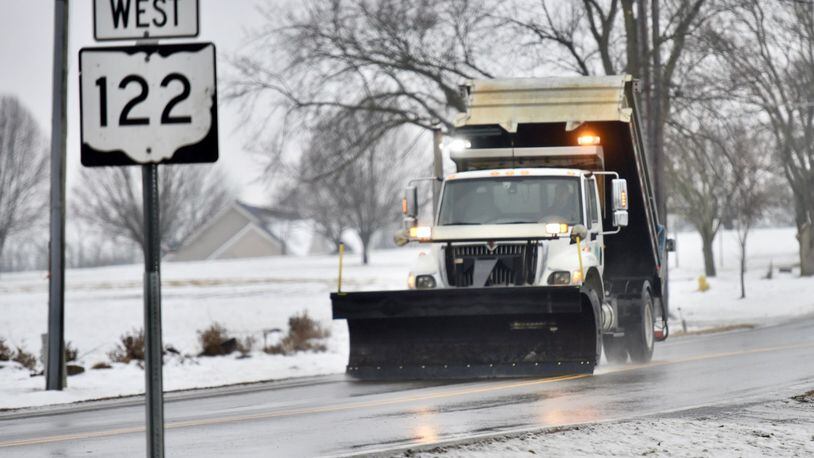But the NWS is predicting some warmer weather this week as temperatures are expected to reach 50 degrees on Wednesday and 60 on Thursday. The warmer weather is also expected to bring some heavy rain this week.
MORE: Winter Weather Awareness: How does Salt help melt ice on roads?
Butler County Engineer Greg Wilkens said plow drivers were out in force Monday to combat the icy conditions on the roads. He noted that by noon, most of the roadways were treated and in good shape.
“We were able to get the high volume traveled roads treated, and they were in good shape (Monday) morning,” Wilkens said. “The low volume roads always cause a little more of a problem, but most of the roads are in pretty good shape.”
He added that second-shift drivers continued to salt the roads, and rising temperatures helped them make roads safer.
“That will do it when the pavement temperature rises,” he said.
Butler County was prepared to deal with the inclement weather this winter, as it had 13,000 tons of salt stored in two barns, each with a capacity of 6,500 tons.
MORE: 2017-18 winter weather outlook shows big temp swings
The county awarded its salt contract for the upcoming winter season to Cargill Deicing Technologies, which submitted a low bid of $58 per ton, almost $10 less per ton than last year. This is a fixed rate, so even if road salt is in high demand this winter, Butler County is locked in at that price.
MORE: Homeless shelter busy as severe winter weather blankets the area
“Having enough salt is not a problem,” Wilkens said. “We are close to full.”
The icy conditions left many schools closed or on a delay and affected some businesses and shelters serving the homeless.
MORE: 6 ways you should be protecting your body in sub-freezing temperatures
Serving Homeless Alternate Housing Of Middletown (SHALOM), was able to provide assistance to those affected by the wintry mix conditions as 22 residents received assistance on Sunday night.
The Salvation Army of Hamilton had to close on Monday, as the hazardous road conditions made it too dangerous for staff and volunteers to get to work.
Tips for driving in the snow and ice:
1. Accelerate and decelerate slowly. Applying the gas slowly to accelerate is the best method for regaining traction and avoiding skids. Don't try to get moving in a hurry. And take time to slow down for a stoplight. Remember: It takes longer to slow down on icy roads.
2. Drive slowly. Everything takes longer on snow-covered roads. Accelerating, stopping, turning – nothing happens as quickly as on dry pavement. Give yourself time to maneuver by driving slowly.
3. Follow at a distance. The normal dry pavement following distance of three to four seconds should be increased to eight to ten seconds. This increased margin of safety will provide the longer distance needed if you have to stop.
4. Know your brakes. Whether you have antilock brakes or not, the best way to stop is threshold breaking. Keep the heel of your foot on the floor and use the ball of your foot to apply firm, steady pressure on the brake pedal.
5. Don't stop if you can avoid it. There's a big difference in the amount of inertia it takes to start moving from a full stop versus how much it takes to get moving while still rolling. If you can slow down enough to keep rolling until a traffic light changes, do it.
6. Don't power up hills. Applying extra gas on snow-covered roads just starts your wheels spinning.
7. Don't stop going up a hill. There's nothing worse than trying to get moving up a hill on an icy road. Get some inertia going on a flat roadway before you take on the hill.
8. Stay home. If you really don't have to go out, don't. Even if you can drive well in the snow, not everyone else can.
Source: AAA
About the Author
